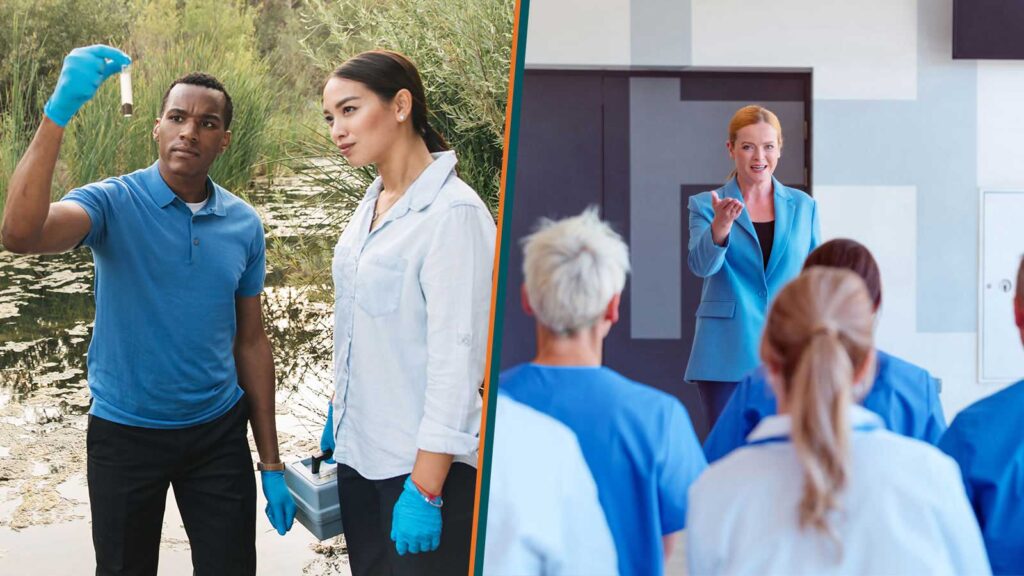Every business has its management challenges, and a healthcare organization is no exception. Good patient outcomes require healthcare professionals to pursue and maintain synergy in communication and collaboration. This doesn’t just mean within each team — intercommunication — it requires active communication between teams: intra-communication.
Hospitals in particular operate at a scale where synergy is both essential and challenging to maintain, and confronted with new challenges in recent years. It is therefore incumbent upon healthcare administrators to provide hands-on and adaptive oversight to ensure healthy synergy. So what can a healthcare administrator do to promote synergy?
To create today’s exploration on this essential health administration skill, we consulted with West Coast University MHA Professor and former hospital CEO Jake Redden for some insights from his vast experience as a leader in healthcare administration.
Here we’ll talk best practices, practical examples, and current challenges to creating a smooth, synergetic healthcare organization, from connecting the dots to maintaining communication and morale between hospital staff.
The Case for Synergy in Healthcare
In the healthcare profession, stakes are high. At the same time, the size and complexity of a large healthcare organization can feel Byzantine. At a high level, good healthcare management requires removing the “invisible wall” between administration and provider. But true synergy must involve cooperation all the way down to the patient-facing level (and back up again), across disciplines and competencies, organizational structure, and even cultural boundaries.

So how does an effective healthcare administrator keep everyone connected?
Professor Jake Redden emphasizes that “the majority of that is setting the vision. As we start to articulate what that vision is, you have to get everyone in the same boat, rowing in the same direction. But that only comes from continually selling that same vision.”
Setting a clear vision as a healthcare leader and including your staff in realizing that vision keeps everyone informed and – equally important – passionate. A passionate workforce fueled by a collective, aspirational objective helps connect everyone with the same sense of purpose. Invigorate your team with both inspiration and clarity, so everyone can get down to the work of it. This is where you let your natural leadership and hard-earned administrative acumen shine.
The Vital (Literally) Importance of Good Synergy
The stakes in healthcare are life and death, with a collective focus on pursuing the former and combating the latter. One statistic that puts the importance of synergy in healthcare in sharp and immediate terms is mortality. Medical error is the third leading cause of death in the United States. This figure highlights the urgency in maintaining workforce symbiosis, and maintaining connective practices between teams to avoid errors attributable to lapsed communication.
Let’s look at it from a single-patient perspective. One recent survey found that almost 20% of the population will have four-to-nine medical encounters each year. Many of these patients will return to the same hospital repeatedly for treatment of a single condition, and will see multiple providers over the course of treatment. A continuous and thorough flow of information during the transition of care is critical to this patient’s outcome. In a boots-on-the-ground example, this could mean implementing the bedside handoff at nursing shift change. But what about the larger group?
“We can do huddles, we can do debriefs, we can do pre-briefs, encouraging those, embedding those into policies,” says Redden. But he also stresses that “what my real job is, is to build capacity in other leaders.”
Which brings us to one of the most powerful skills in a good health administrator:
Empowering Teams and Fostering Leadership
Since synergy is all about sharing, let’s talk about sharing responsibility. A great leader is an authority but not an authoritarian. Mentoring and teaching the emerging leaders in the team is one of the primary ways a healthcare administrator builds strong communication and community among staff. So how do you empower your team to learn and exercise leadership and confidence among each other? Redden provided an example of how he creates an empowering environment for his teams:
“In discussion, sometimes I’ll play the novice, and not have an answer to allow someone else to give me the answer,” Redden says. “This is to empower them so next time they can take a lead, so they can watch out for each other and stop each other from making those errors before they hit the patient. And instead of me having to be the fixer, I’m building a workforce of fixers. And that’s a force multiplier in how we make monumental change across healthcare.”
Empowering your staff so they don’t feel powerless when you aren’t there to “have the answer” helps reduce a team’s dependency on you, and build the confidence to work together, communicate, and share knowledge and responsibility. Helping a team mature into independence and interdependence to build that trust to work, act together, and share expertise for a greater whole.
Institutional Knowledge: A Shared Responsibility
Speaking of shared expertise, the speed of advancements in healthcare and technology have changed how institutional and medical knowledge lives and travels in a team.
“It used to be, 50 years ago, you probably had 80% of your healthcare knowledge inside a physician’s brain,” says Redden. “And today the amount of information is doubling every two and a half years. And even right now, 80% of the healthcare knowledge that we have has been discovered in the last 10 years. So it’s impossible for any one person to be really great by themselves. It requires a team approach.”
This means encouraging an atmosphere of curiosity among staff – an environment where everyone feels comfortable asking questions, and everyone is generous with their knowledge. To Redden’s point, this applies crucially to medical expertise, but it can also apply to practical knowledge, even something as simple as showing a newbie where supplies are kept.
But the newbies have knowledge to share, too, and more seasoned staff should be taught openness to receiving new knowledge from their younger colleagues, who might be more tapped into recent thinking, technology, or even cultural sensitivity.
Technology and Communication: Bridging the Generation Gaps
As a leader in healthcare, you’ll be dealing with staff from multiple generations. And each of these generations grew up with different communication technologies and preferences. This can lead to some disruption in synergy when your team has different comfort levels with different mediums of communication, from analog to high-tech.
Advances in healthcare information technology (HIT) create significant advantages to both providers and patients, but the pitfalls come when that same technology creates communication failures if personnel aren’t adequately trained or versed in the information-sharing tools being used.
“There are some people who like emails, some like written policy,” says Redden, “So you have to get to know your individual staff, recognize where they look for that communication to occur, and then you gotta do the check backs to make sure they understood what you put out or what that policy is.”
Developing a comprehensive communication strategy that supplements digital and papertrail documentation with in-person checkpoints, handoffs, and huddles is a worthwhile extra step to make sure nothing gets lost in translation, or lost in the inbox, for any of your staff.
In Summation…
We thought an anecdote Redden relayed provided a nice endnote any healthcare administrator can always tap back into when thinking about how synergy in healthcare should work:
“There’s a great story I love about a tour that was happening in NASA and they opened up a door and there was a janitor cleaning the floor and they asked the janitor, ‘so what’s your job here?’ And the janitor looked up and said, ‘I help put people on the moon.’”
So as you lead your team, remember that all of you are reaching for the moon, together.
WCU provides career guidance and assistance but cannot guarantee employment. The views and opinions expressed are those of the individuals and do not necessarily reflect the beliefs or position of the school or of any instructor or student.



